#collaborative creature design
Explore tagged Tumblr posts
Text

A collaboration adoptable done with my friend Eddy Currently open for money offers, starting from $100, payment via PP, you can DM me if you want to make an offer! Current offer: $200
#creature design#character design#oc#original character#feral#dragon#noodle#avian#adopt#adoptable#name your price#nyp#ufs#up for sale#collaboration
383 notes
·
View notes
Text

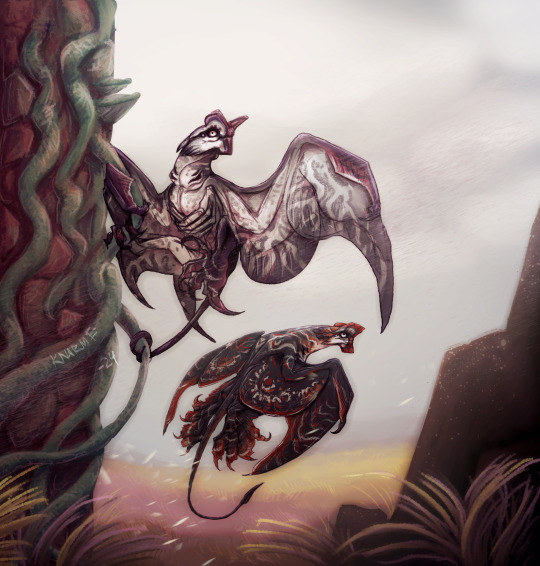
Distant cousins of the jungle's stingbat, the aptly named stunbat (Tsealìm in Na'vi) is a native of the Txepìva volcanic plains that hunts by diving from great heights and colliding with their prey head-first, stunning them.
Their head is blunt, with a threefold crest reminiscent of the great leonopterix's dual one, but significantly more ossified. Their neck is thick and muscular, to help support the structure, but also to weather the high velocity impacts.
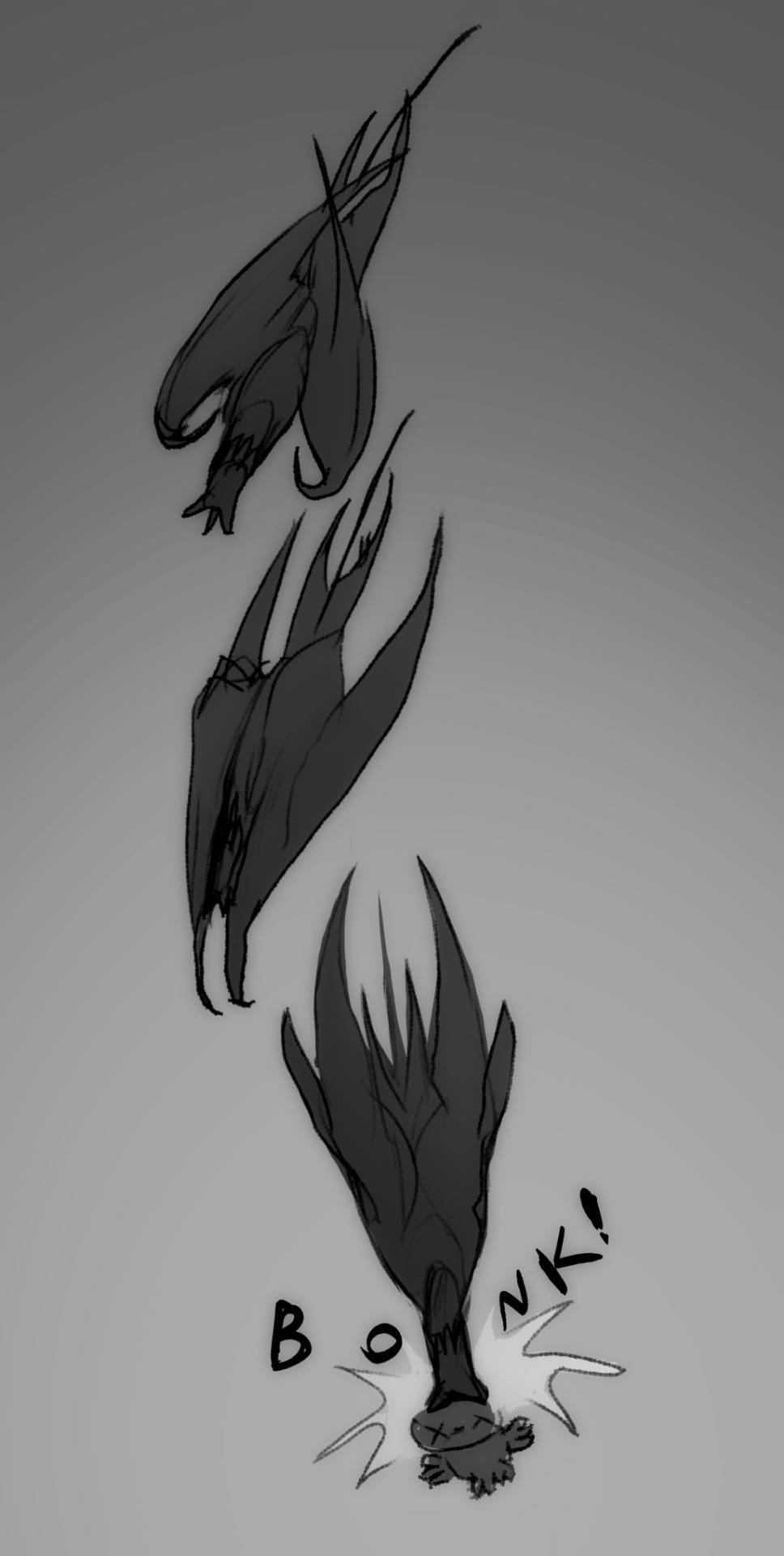

The hands, small and with fused fingers in jungle stingbats, are much larger here, and used to catch stunned prey falling from the sky, or pick them off the ground as they swoop down. It also allows stunbats to eat on the fly, as it were, as the plains' chaotic environment doesn't always provide them with safe perching opportunities.
Stunbats have short, prehensile neural queues that retract under thick, keratinous neck frills. The extra mobility of this limb allows them to make quick connections while in mid-air, front to back, back to back, or belly to belly, the latter being the more commonly seen one, accompanied by a stabilising "handshake".

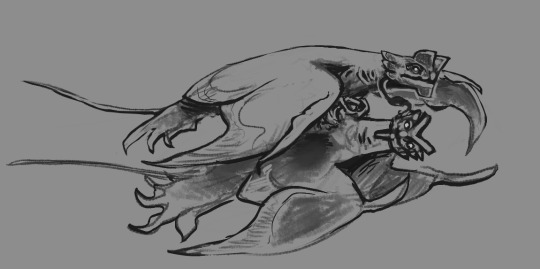
The stunbat's vision is excellent. Early research by Eyris Makri with the Tuin clan of the Txepìva showed that their domesticated stunbats were able to spot prey up to 4 miles away, seeing clearly at ten times the distance of their Na'vi handlers. Their primary eyes show a high concentration of foveas, giving them enough focus to clearly distinguish prey moving against the complex backdrop of the plains and lava fields.
Although the stunbat's barbed tail has lost most of its poisonous sting, it is still used in defence against larger predators. Their best defence, however, remains a Na'vi bow.
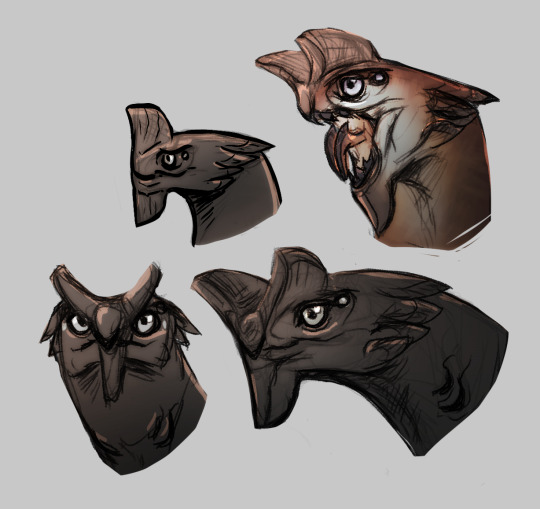
It is hard to tell exactly when domestication started, though the olo'eyktan of the Tau'un clan claims one of his ancestors was the first to tame a stunbat. We're told this happened during the "Time of Long Nights", but dating that event is equally complicated. Current estimations are a minimum of two millenia.
During that time, the stunbat's range remained tied to the volcanic plains of the Txepìva clans, although the species has been observed by Serafiina Hukkala as far out as Mons St. Helen. One must note that the stunbat is unlike our previous study case of the Viperhound, which are bred for various purposes. Interviews with Txepìva hunters (Makri et al.) suggest that their relationship to the Na'vi is similar to that of cats and humans, with multiple domestication events, beneficial to both species. Na'vi led breeding appears to be very incidental, as stunbats tend to fly off to find mates in the wild, rather than mating among their clan's flock.

This species is significantly larger than their forest cousins.
The most common uses of stunbats are for scouting and hunting. While hunting of small game is extremely similar to what humans once achieved with eagles, stunbats also take part in hunting expeditions for large prey.
They are used to follow the movements of herds, but also to help separate young calves from their mothers, or the weak and wounded, by dive bombing them (Hukkala et al.) They understand complex orders, communicate with clicks and shrieks, and will come to hang on the queue or harness of their paired Txepìva to share more detailed visuals through Tsaheylu.
This is also how they are used for scouting. Serafiina Hukkala postulated that the stunbats' mated pair lifestyle influenced Txepìva culture by making the act of scouting a couple's task. Scouting, we must remind the reader, is a lot more crucial to the Txepìva, who have no qualms waging war against each other for the domination of water sources and fertile land. Raiding parties, while not frequent, are a banal part of life on the plains. Even small children learning to work with stunbats will be sent on sentry duties, often on the back of a Lenonin Hound.
The reason mated pairs of stunbats are favoured is because of their long flight range and their ability to connect together in mid-air. This means one side of the couple can move far ahead, and report back to their partner, already extended to the edge of their range. A couple of scouting stunbats effectively covers double the range a single hunter would.
Stunbats are occasionally used to communicate with similar techniques. While one half of a pair can be sent to deliver a message to another tribe, the other remains with their clan (often brooding). The homing individual (whichever has best endurance, as both sexes feed and brood chicks at will) can find its way back to them even if the clan is on the move. More research is needed on their communication capabilities.
When travelling or staying in temporary camps, stunbats are housed in loose baskets designed to let them hang onto the side. These carriers are custom made by every clan and come in many forms and sizes. Brooding stunbats are carried, either by a Na'vi who will fashion straps to turn the basket into a backpack, or tied to the back of Leonin Hounds.
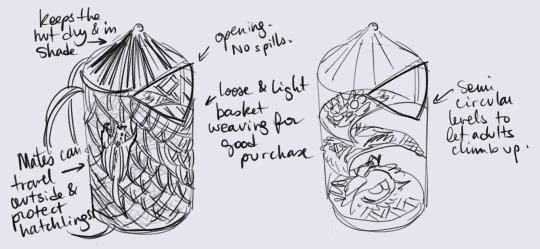
In more permanent camps, the Texpiva craft treillis to give them places to hang from. Serafiina Hukkala reported a clan that arranged dried branches and material for firewood as perches, while Eyris Makri stayed with a couple who fashioned fake branches at the top of their tents, like rafters. Both heard reports of clans that house their stunbats along with their livestock, but the practice seemed frowned upon.
The bond between Na'vi and Tsealìm needs further study. It isn't as exclusive as with an ikran, but much more complex than with direhorses. Stunbats bond strongly with a small family node, and more weakly with the extended family and friend group. Tsaheylu is typically only done with their main Na'vi hunters, although the stunbat can be introduced and passed down to children.
Emergency tsaheylu was witnessed twice by Makri, when a scout had urgent reports and the stunbat was sent ahead. Connection was made with the clan's tsahìk, who had a habit of bonding with every newborn stunbat. The practice, we were told, can be controversial.

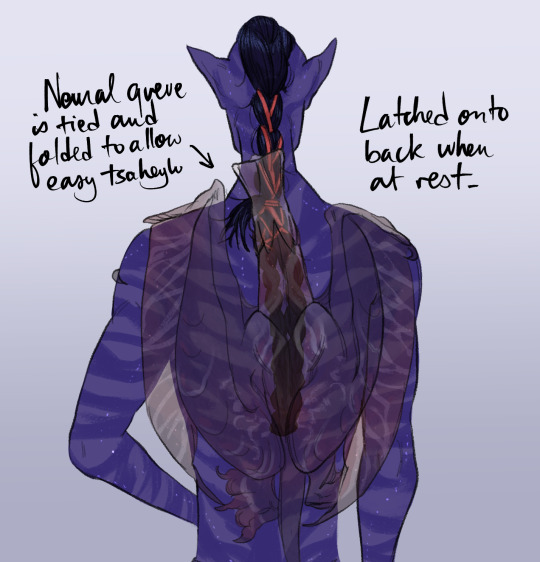
Hunter depicted without ornaments, to highlight the process of Tsaheylu.
Some clans craft harnesses for hunters to better carry and support their stunbats, while others prefer natural body-to-body contact. The folding or tying of the neural queue to allow for better access to the kuru/tendrils seems universal among all interviewed hunters and scouts. Different styles were observed and will be presented in our published notebooks, after our paper on the use of stunbats in skirmishes and outright warfare, as the Txepìva practice it.
Part II of @straydaddy (art and design) and @bluedaddysgirl (lore concept + final art entry) in-world collaborative study, "Introduction to the Txepiva clans, their nomadic pastoralism and niche selective breeding practices in species of stingbats and viperwolves". On twitter we are Knarme and Bluedaddysgirl
#avatar#atwow#avatar 2#jc avatar#avatar fan lore#fanart#aliens#alien biology#xenobiology#xenozoology#speculative evolution#creature design#concept art#creature art#creature concept#alien concept#fan art#collaboration#alien design#alien creature#spec evo#spec bio#speculative zoology#speculative biology#na'vi#na'vi oc#pandora#stunbat#stingbat#tsealim
153 notes
·
View notes
Text

If James Cameron won’t give me arctic Na’vi I’ll do it myself
#This was pretty fun to work on! I loved studying Avatar’s creature design#The arctic Na’vi were a collaboration between me and sashimiskulls!#artists on tumblr#artwork#character design#digital art#digital illustration#james cameron avatar#avatar 2009#na’vi oc#creature design#Avatar#my artwork
19 notes
·
View notes
Text

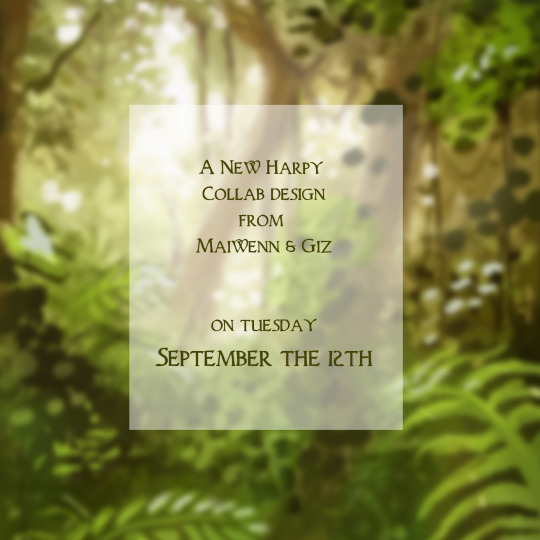
A new -adoptable- harpy design is on the way, once again a collab the awesome Maiwenn We can’t wait to introduce you our latest baby, next tuesday, the 12th of September ! Just in time ! We're still in summer !! XDD So... can you guess which birdy it is this time ?
--------------- Un nouveau design - adoptable - est en approche, cette fois encore une collab avec super Maiwenn Nous avons hâte de vous présenter la nouvelle frimousse, mardi prochain le 12 septembre ! Juste à temps !!! vu qu'on est encore en été !! Alors... Avez vous une idée de quel pioupiou a été choisi cette fois ?
#adoptable#harpy#character design#creature design#bird#fantasy#anthropomorphic#avianpeople#mythical creatures#original design#collaboration#art collab
8 notes
·
View notes
Text

Happy October everyone! Friendly reminder that my commissions are open!
All pricing information can be found via the link above.
Be aware, if you have received a commission from me in the past that my prices have changed (certain things have gone up and certain things have gone down for balance). I’ve also streamlined the options, so if you’re confused what to select to get exactly what you want, please reach out!
Also, I’ve added a chibi option for those interested in designs such as my falin or InvictusCon exclusive Arthur stickers. These are a flat rate, no add-ons.
I will draw:
Real people
Original characters
Fan art
Furry characters
Monster/creature designs
I will not draw:
Explicit nsfw (artistic nudity and suggestive things are fine; discuss with me beforehand)
Cars/complex non anthropomorphic machinery
If you are unsure whether I will take a commission, please don’t hesitate to reach out so we can discuss content. If you have a commission that you think I can do but it doesn’t fit within the options on my commission page, we can discuss it and I will provide a price.
I reserve the right to turn down any commission for any reason. If your commission is rejected, you will receive a full refund.
These commissions are for personal use only. If you are interested in collaborating for commercial work, you can reach out to me at [email protected].
And as always, regardless of if you are interested in a commission, my tip jar and ko-fi memberships remains open. (My fae tier members get monthly sketch requests!)
#commissions#my art#shop update#digital art#I just got a new desktop so comms and rbs of this post are GREATLY appreciated
156 notes
·
View notes
Text

To celebrate the digital release of Triangle Agency, I wanted to talk about some of the art that helped shape the core rulebook! Today I'm going to talk about the ARCs - the Anomalies, Realities and Competencies that make up the characters in Triangle Agency.


All of the Anomaly illustrations were done by @theveryworstthing, one of the most inventive character and monster designers I have ever met, and an extremely kind and hard-working person. Her fluid and expressive figures really capture a whole story in a single creature, and it was so much fun seeing the monsters she would bring us.


The Realities were a collaboration between G.C. Houle and myself, which was just a joy. I love getting to build characters and a scene with another artist, and G.C. is always wonderful to work with. I love in particular their ability to capture everyday people, which felt crucial for the agents’ Reality scenes.


@darksunradiance’s work covered all of the Competencies, and was also integral to defining how the Agency presents itself, how it makes itself felt and known, and its internal documents. I love Nate’s evocative gestures, the contorted and contradictory figures - and the use of sharp red on white in the minimalist space provided a simple and dramatic foundation on which we could build a strange and complicated world.
369 notes
·
View notes
Text
青白之魅 1: Introduction & Presentation
1 Introduction & Presentation // 2 Background & Influences // 3 Hair & Makeup // 4 Set Design // 5 Clothes & Accessories // 6 Conclusion
tw snakes i think? yeah if you don't like snakes you might wanna just skip this one
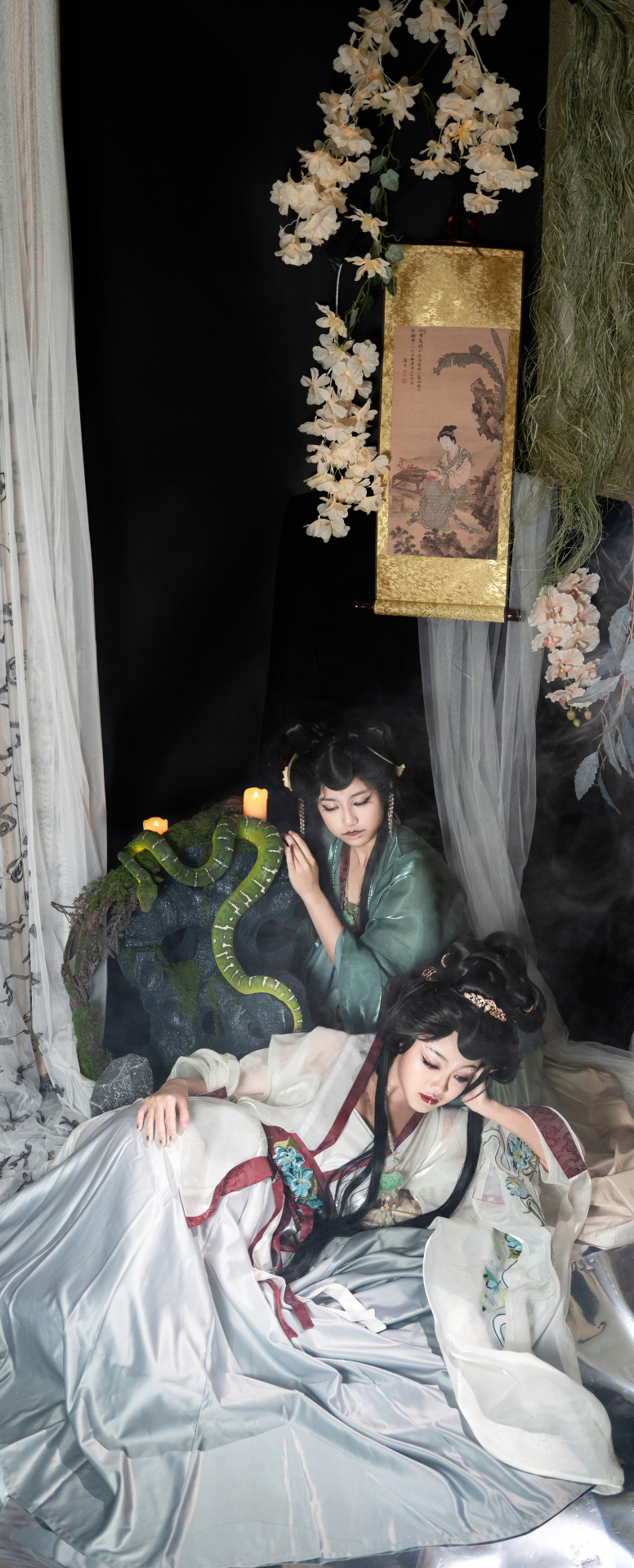
Taking a break from the informational stuff—I would like to present a project that my sister and I (Cloud9 Hanfu) just released on Lunar New Year: 青白之魅!This is a photo project that we've been working on since last summer, with the intention of celebrating the year of the snake, as well as to show the hanfu community that has supported us for so long what they've done for us and what they've made possible :>
I've got a blog now aka a poorly disguised excuse to yap for several hours straight, so I'm going to be documenting the design background and symbolism behind my work on this project through a series of long posts.
This'll be split up into 6 parts, which I'll link as they go up UPDATE they are all up!:
Introduction & Presentation (this post): introducing the project's intentions and the presenting the first set of photos
Background & Influences: going more in-depth about the particular sources and pieces of media that inspired this project
Hair & Makeup: opera references and stylistic choices in the design of the hairstyle for both characters and the makeup of the green snake
Set Design: references to Green Snake (1993), explaining the symbolism in some of the props
Clothes & Accessories: process of designing the clothing, behind-the-scenes sketches, archaeological background
Conclusion: reflection on the whole process + Things I Would've Done If I Had Infinite Money And Time
For those of you who just want to look at pretty pictures and move on with your life—this post is for you! If you want to see all the nerdy guts that went into this thing though, keep an eye out for more ;)))
Even if nobody reads this I'm gonna regard it as an exercise in reflection, or just an act of documentation that I might be able to come back to later on. But if you do read it and like it then yay! :)
青白之魅

青白之魅/qing1 bai2 zhi1 mei4/'Enthralled by Green & White' is a photo project primarily based on 白蛇傳/白蛇传/bai2 she2 zhuan4/the Legend of the White Snake. It's one of China's Four Great Folktales, one of the most well-known stories in Chinese culture.
It tells the story of two snake spirits who have taken the form of human women, the White Snake and her younger sister the Green Snake. The story is set in Hangzhou, China, and depicts a dramatic romance between the White Snake and a human scholar. We set the focus on the two snake sisters instead of the romance.
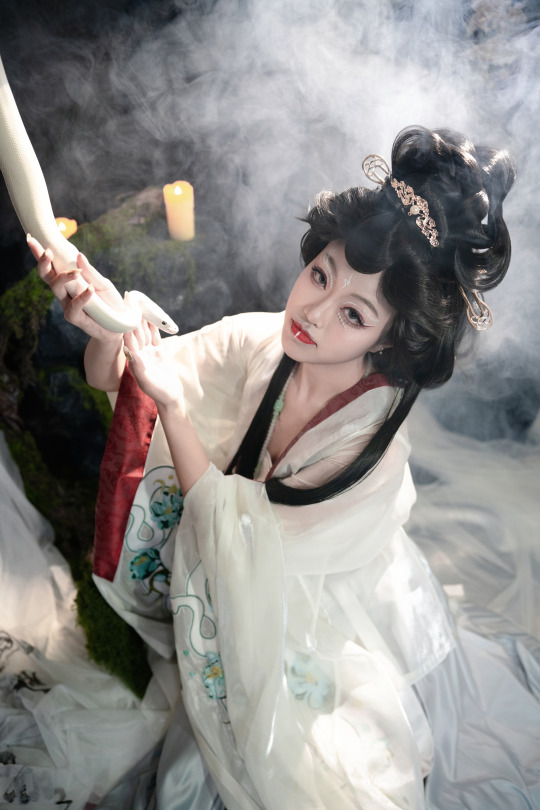
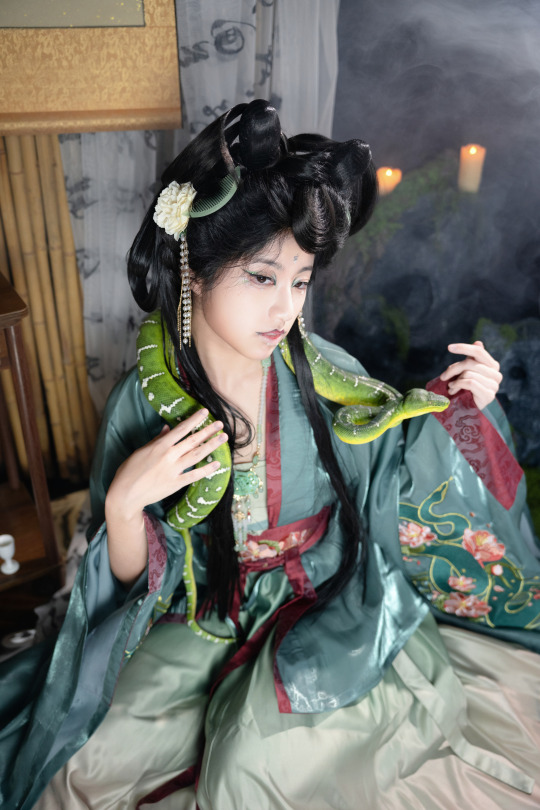
This project features my older sister Yulan and I as the White & Green Snake, respectively. This was a collaboration between three organizations: Cloud9 Hanfu, our brand; Art of Scales, a professional snake handler & ophiologist from Riverside; and Bloomin Studio, a comprehensive photography studio from Santa Ana, CA. None of this could have happened without them!
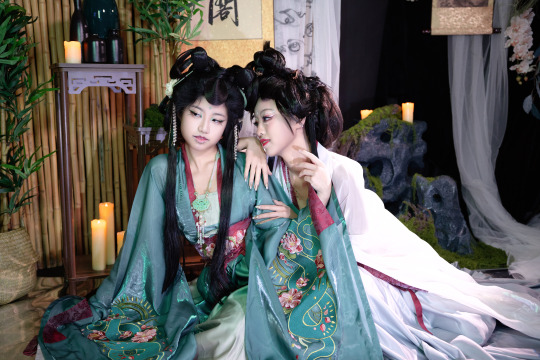
This year is the Year of the Snake. Snakes are often demonized, especially (though definitely not only) in Western culture, and seen as inherently evil or malicious creatures, partly because of the very real danger that some species pose. Like all animals, though, they are simply a part of the natural world—we happen to think they are quite beautiful evidenced by the fact that my sister owns a truly egregious number of pet snakes! We wanted to bring the Legend of the White Snake to life through our hanfu photoshoot with real snakes.
Our photo project aims to show that, much like the public interpretation of snakes, and the Legend of the White Snake, Hanfu is a multifaceted concept—full of rich history, self-contradictions, and a reflection of the people that engage with it. We hope that, similar to the rise of sympathy given to these characters with time, we can reduce fear of the unknown and share the beauty of our culture, our clothing, and (Cujo's) snakes with everyone this year.
青白之魅
白蛇之魅
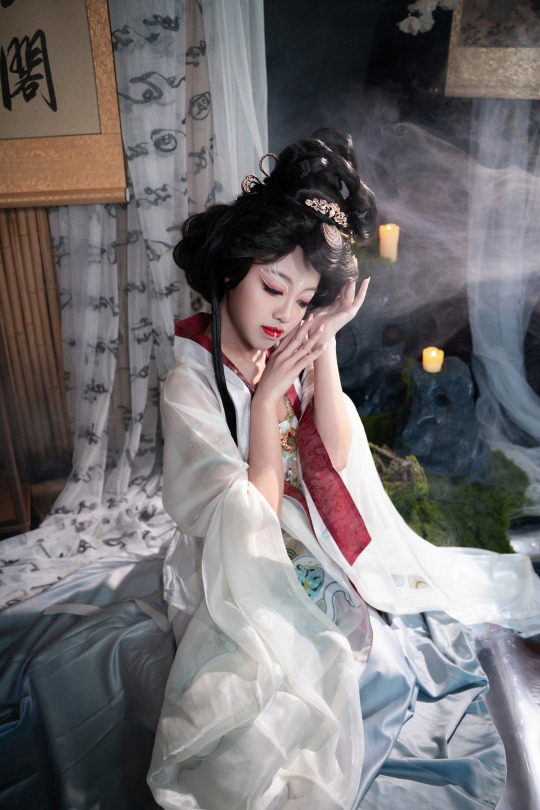
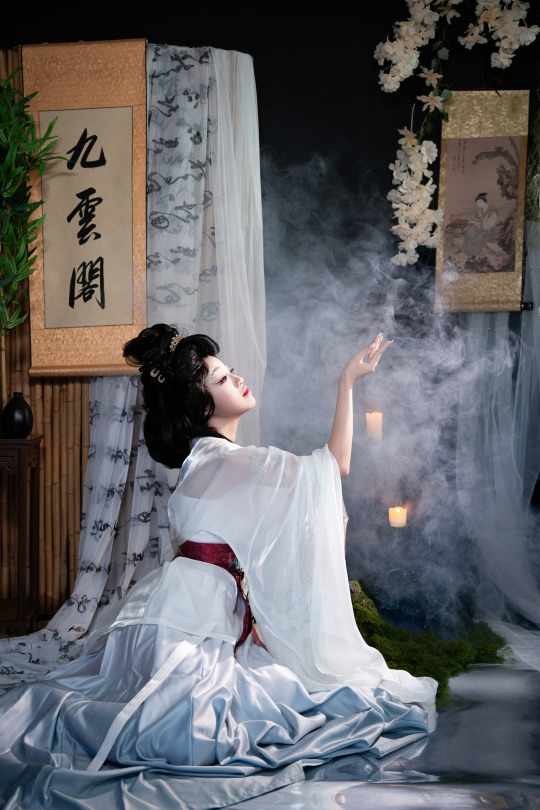
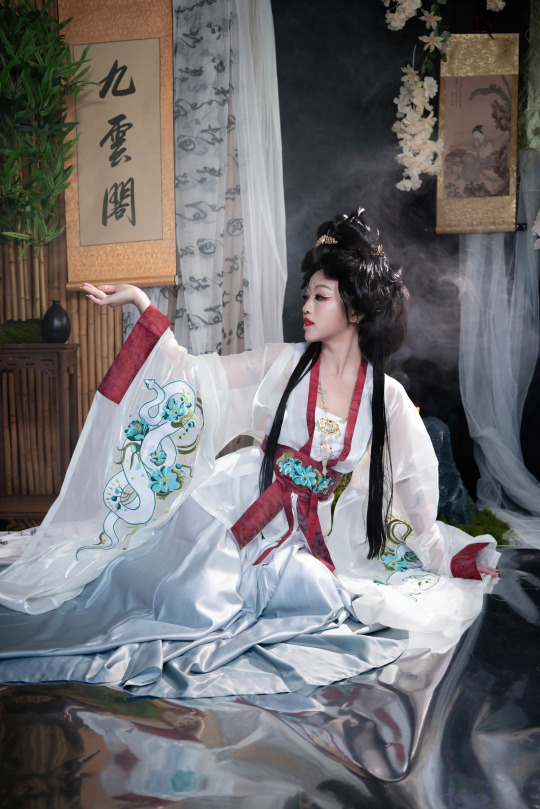
The older White Snake sister is named 白素貞/白素贞/bai2 su4 zhen1/Bai Suzhen. Bai Suzhen, also called 白娘子/bai2 niang2 zi0/Madam White is the main character of the Legend of the White Snake.
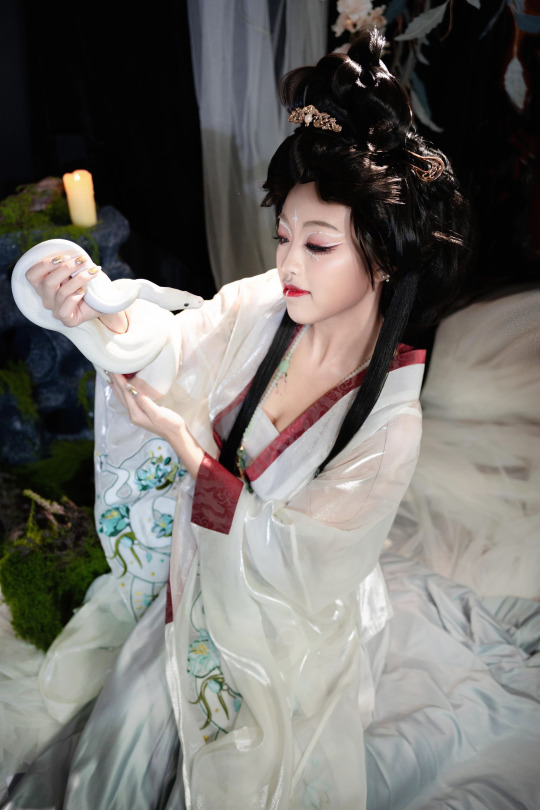
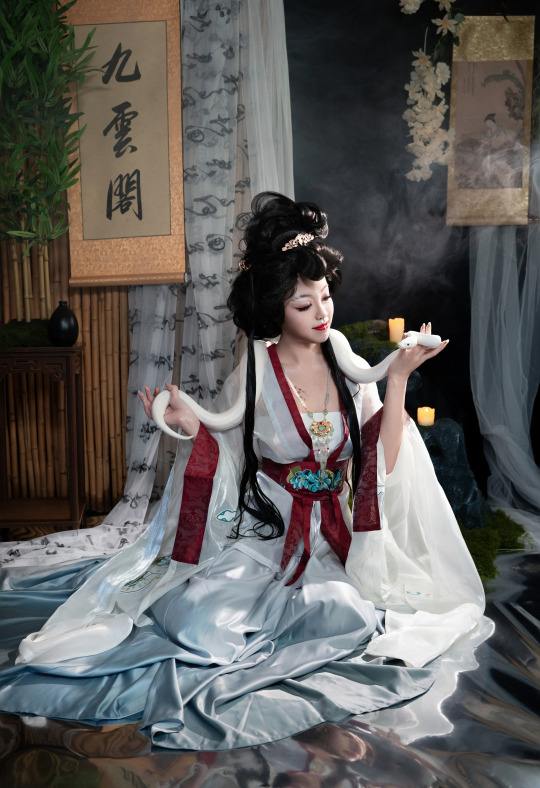
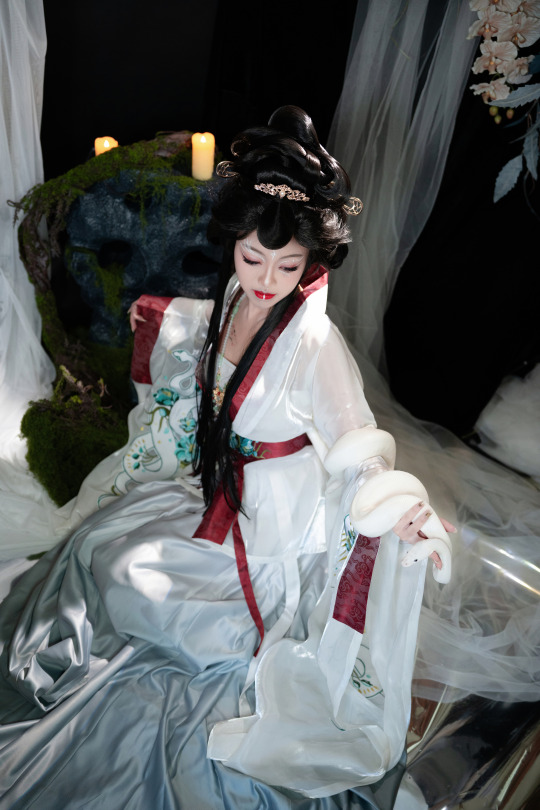
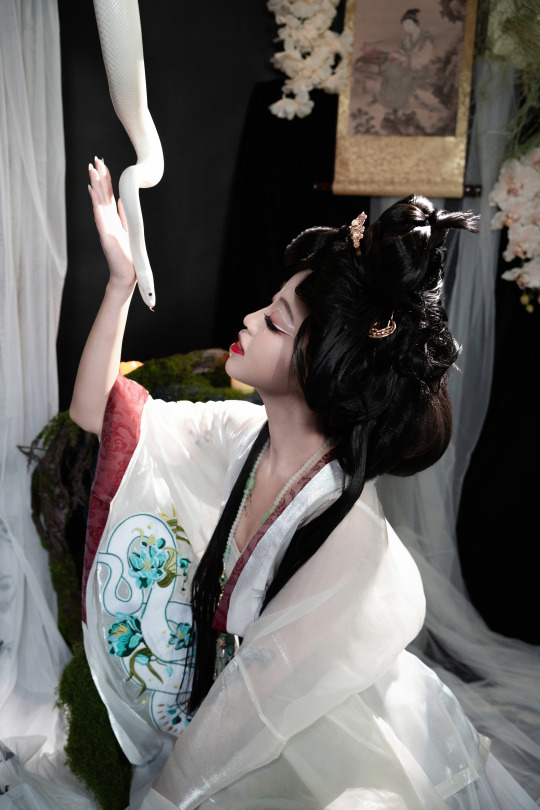
Spirit the blue-eyed lucy represented the White Snake in this shoot! He's a blue-eyed leucistic (<- a highly coveted morph of ball python) ball python/royal python. He was truly one of the most beautiful snakes I've ever seen, an absolute sweetheart and posed like a dream. I applaud his core strength!
青蛇之魅
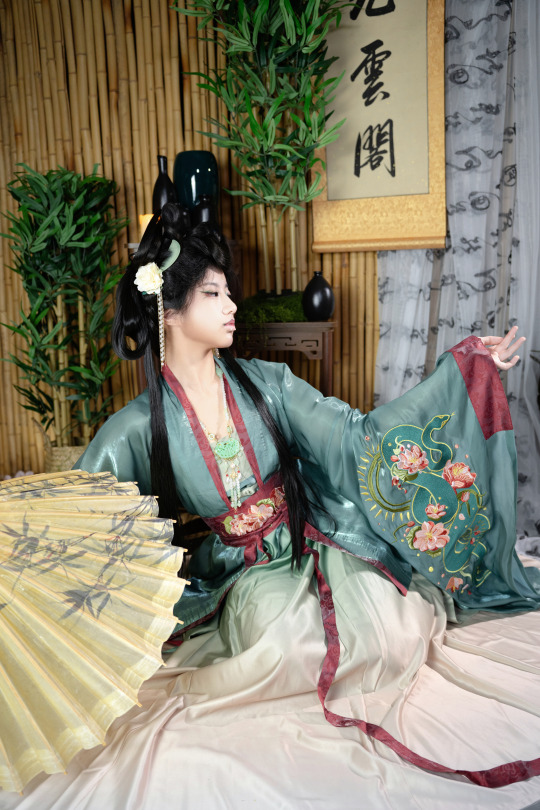


The younger Green Snake sister is named 小青/xiao3 qing1/Xiaoqing. 青 is a color that doesn't translate directly into English—it covers colors ranging across what we might call blue, green, teal, or black (see the grue phenomenon). Green is the translation that most people agree on.
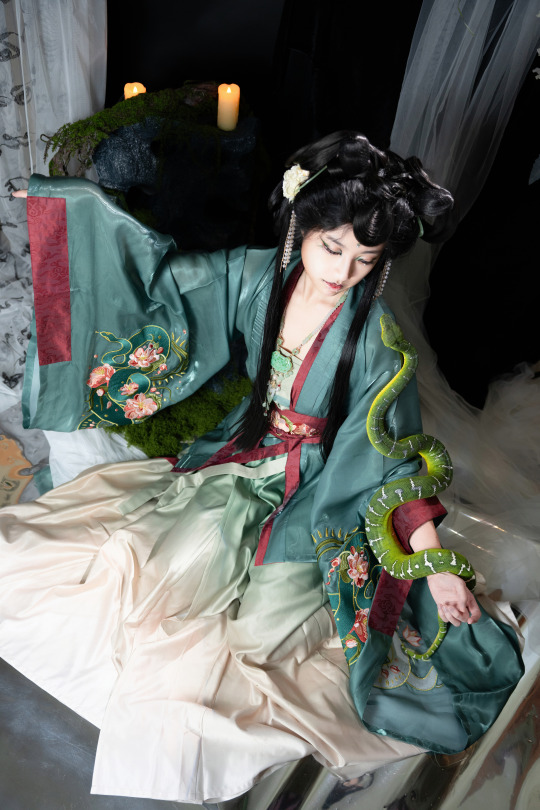
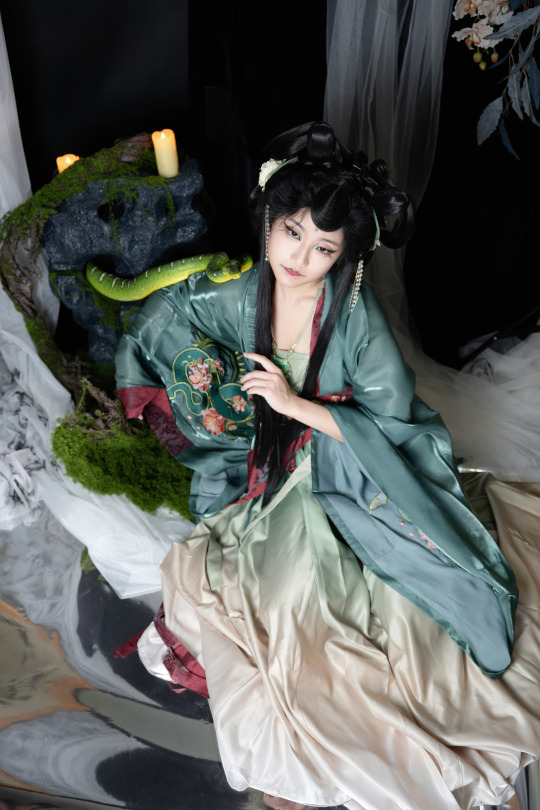
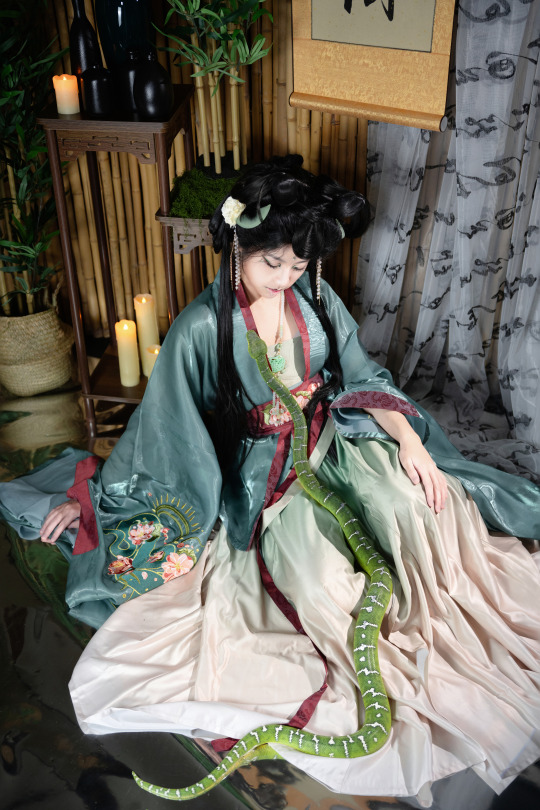
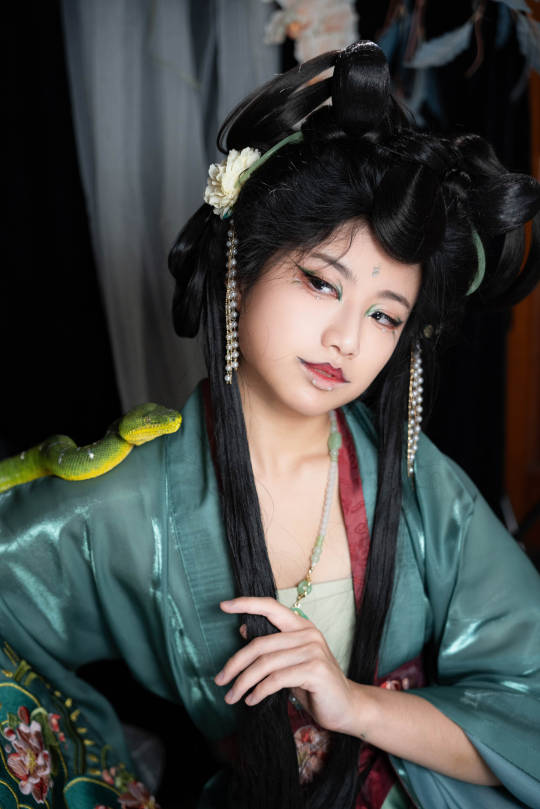
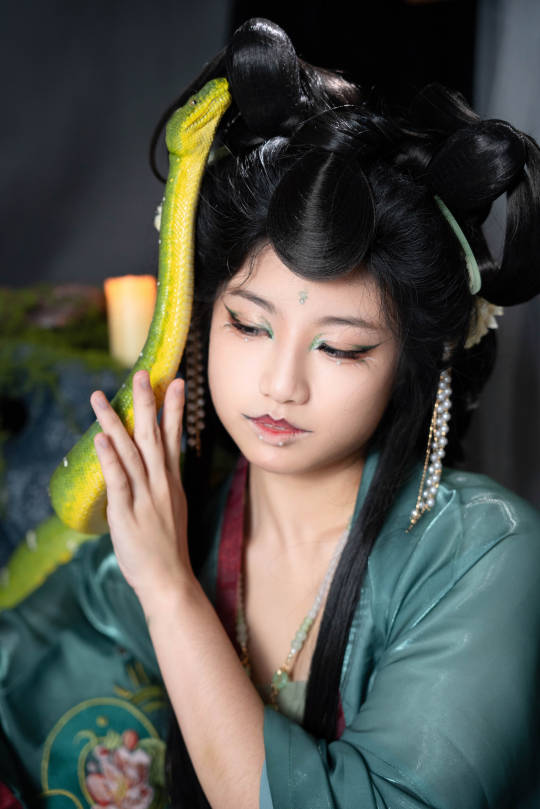
Dragun the emerald tree boa represented the Green Snake in this shoot! He was super calm and chill, even when some of my hair got stuck in his scales (sorry bby :((((), which is saying something for an emerald tree boa (they considered extremely exotic and are usually cranky asf). He has a deviated septum and makes a funny hissing noise when he breathes! It was very calming.
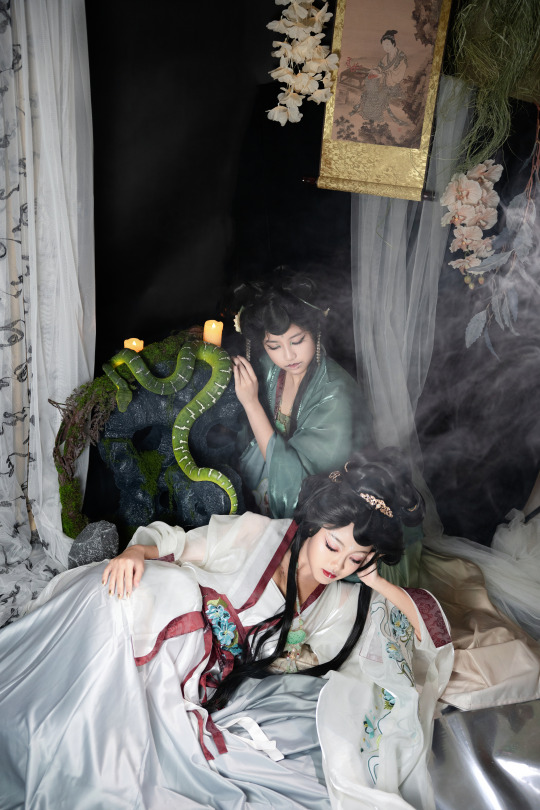
If you actually read this whole post through, congratulations! Feel free to ask if there’s anything you’re curious about that I didn’t cover or doesn’t look like I’m going to cover. (And by ‘feel free’ I mean there’s a little guy in my brain doing his best impression of someone dying from thirst in the desert and only your validation can save him.)
1 Introduction & Presentation // 2 Background & Influences // 3 Hair & Makeup // 4 Set Design // 5 Clothes & Accessories // 6 Conclusion
#hanfu#hanyuansu#chinese hanfu#chinese fashion#chinese history#hanfu fashion#hanfu photoshoot#hanfu art#cloud9 hanfu#cloud9hanfu#九雲閣#photoshoot#project#long post#青白之魅#series#photography#hanfu photography#snake#snakes#legend of the white snake#白蛇傳#white snake#green snake#ball python#royal python#emerald tree boa#northern & southern dynasty#南北朝
94 notes
·
View notes
Text
With a total of 1,176 votes tallied, the preferred plushie poll winner with 28.8% of votes is…

What a close one! Jonathan came in with 27.7%, the mysterious Mr. Morse with 24.9% and, delicious irony of ironies, London Dracula with 18.9%. Rest in pieces. Now, what does all this mean going forward?
First, just to reconfirm: I will absolutely be looking into the costs for having more than one plushie character produced at a time. For all that Mina has the top spot if it comes down to a solo run, Nobody Wants to Separate the Gothic Horror Soulmates, even as wee little plushies. It hurts my heart to think of. Mina and Jonathan deserve to sit side by side on everyone’s pillow. Just as Quinn Morse deserves to haunt the pillow next to theirs while casually throttling and carving London Dracula into pieces. For enrichment.
But beyond that, some other key things:
How is this getting done?
Sadly, I was not a cool enough kid for Makeship to greenlight a collaboration with me. Tragique. But while I was sitting around waiting for them to get back to me, I had time to browse around for other options. During that sniffing around I dug up a couple of promising manufacturers—one of which has some really neat options for not only plush toys, but all sorts of bric-a-brac like stationery, shirts, bags, cups, et cetera—and I plan to reach out to them for quotes to start with. Nothing really gets to move forward until I can nail down prices and the amount of X plushies to be made.
I am more than a little hesitant to tell anyone MAKE ME 1000+ PLUSHIES, PLEASE, THE TUMBLR POLL SAID THEY’RE GOOD FOR IT. These aren’t as simple as print/make-on-demand products, so I need to be careful estimating the amount of folks ready and willing to drop money on the little guys. But I will keep everyone updated on the numbers regardless!
Sooo is this a crowdfunding thing or an investment or what?
Don’t know yet. I am still between jobs at the moment—reminder to check out my Ko-Fi if you want to drop me a buck or commission some art!—but if this is something I can safely drop some of my own money in with the guarantee that it will let me do better than break even, I’ll do what I can out of pocket. However, if the cost of making something of good quality turns out too steep, I’ll start looking into stuff like Kickstarter and Backerkit and so on. I want to be sure I’m not gutting anybody’s wallet to pull this off and I want to be double-sure that what we’re paying for isn’t some flimsy throwaway junk. We are all here on the same Dracula book club starving artist site, so It Has to Be Worth It and not a money-sink for anyone.
Got it. Any other info to spare?
For the plushies specifically, this is when I’ll start:
Polishing up the current four designs into cleaner illustrations with different angles to provide for mockup samples with whoever I pick to manufacture with. If I get stuck on something—(which is likely)—I may throw up another poll to bug everyone about palettes and fashion choices. I have a few more designs I haven’t dropped yet for Epilogue Harkers, a non-Bloofer Lucy, and keychains that I’d love to share too!
Eyeballing materials. I’m already picturing a very close-cut cloth for the build and clothes, but I need to decide on filling too. Stiff overstuffing to hold a pose versus softer/lighter plush for floppy cuddleability.
Poking at other character roughs, ala the Suitor Squad, the Weird Sisters, Van Helsing, Renfield, and Baby Quincey. And if all of those go well…
…maybe some designs for other favorites in the public domain playground. (Looks meaningfully at Clarimonde, Carmilla, Victor Frankenstein and the Creature, the King in Yellow, too many others.) ((But that’s all far-future stuff at the moment.))
Cool! But you also mentioned something about other merch?
I did.
Because goddamn do I want some Dracula-themed stationery. Journals! Memo pads! Pens! Every day we don’t have these things with the Harkers’ mark upon them is a victory for the forces of Count Dracula’s document-destroying evil. Likewise for shirts, totes, mugs, keychains, face masks and other things that could use some novel-flavored goodies. Hell, I’ll probably even get on with making stuff for The Vampyres to link on my website too. Because I am. Maybe behind on that. By several months.
Anyway.
I’ve got to start working on some designs for those too while the plushie process is progressing. Pray that my carpals don’t get tunneled.
Nice! Sounds like your plate is pretty full. So that’s it, right?
:)
Arcane?
:3c
Arcane. I need you to tell me this is all you’re working on.
>:}
Arcane.
Please stand by.
I have a little treat brewing for the Dracula Dailiers and @re-dracula folks in honor of a very special day for our good friend Jonathan Harker.
#I am scheming#my art#my writing#dracula#jonathan harker#mina murray#mina harker#quinn morse#the vampyres#c.r. kane
161 notes
·
View notes
Text

"I made these"
Sagan 4 is a collaborative worldbuilding / spec evo project that anyone can contribute to. See my pinned post for more information.
#speculative evolution#creature design#original species#worldbuilding#collaborative project#collaborative work#collaborative writing#Sagan 4
2 notes
·
View notes
Text

I have a project to present to you,
dear creatures. One close to my heart that -should it come to fruition- will require your participation. A couple years ago I made a design, The cycle breaking Ouroboros. My skills have grown since then and I try to do a redraw of said design every year.
I’ve seen a few people get this design tattooed on them, I’ve sold a lot of tattoo passes of this particular design but sadly; I have yet to actually tattoo this design on anyone myself.
I aim to fix that this year; but I want to be specific. I really want to do a series of tattoos with variants of this design—featuring different types of snakes on different people. People who have all broken cycles in some manner. If the participants are open to it, maybe we could record the session and talk a little about life. If they rather be private, then we can just record the tattoo process itself.
For these tattoos I’d like to ask for below my minimum, so I can get supplies - $60
and to ensure the participants are serious and will commit to a session.
I’m located in the mountains of Southern California and if this is a project you’d like to be involved in please message me and let’s set something up. This is an idea close to my heart and it will be handled with sensitivity and earnestness. Ultimately this is art I wish to create that requires the collaboration of very special canvases and I hope perhaps I can find them.
Cheers to the cycle breakers.
-Tag

#the cycle ends here tattoo#the cycle ends here#ending the cycle#cycle breaker#shoutout to the breakers of generational curses#breaker of generational curse#tag devilish tattoo#tag devilish#tattoo#tattoos#occult tatoo#medieval tattoo#etching tattoo#woodcut tattoo#witchy tattoos#witchy tattoo#ouroboros tattoo#ouroboros#snake tattoo#art#artist#illustration#tattoo design#engravers style tattoo#engraver tattoo#engraving tattoo#cycle breaking#mental health tattoo
230 notes
·
View notes
Text
Snippets. 🐺💜
Nathan: "This team has done some amazing work 😍" [source]
devs Mack Carruthers and Greg Towner worked on Morrigan's transformation in the new trailer [source]
Violet: "🥰 can't wait to share more with you guys 👀" [source]

Violet: "Happy to finally have my first authored blog (with help from my AMAZING TEAM of course!) to share with you guys!!! Check it out and pre-order DATV now! 🥰🥰🥰" [source] [bloglink]
In this thread, Derek highlights a compilation of shots from the trailer that he made, worked on in-tandem with others, or polished

Derek: "And that’s all the stuff from me in the trailer! I feel so incredibly lucky that so much of my work made it into this AMAZING trailer. Can’t wait for you guys to see more. 🧡 I wanna add: it takes an army to make these scenes. While I did character layout, camera animations, animation polish, bug fixing and technical stuff, there’s still a plethora of folks who touched these scenes. Matter of fact, our work still isn’t done. So I gotta thank: writing, level art, VFX, lighting, sound, character art, performance capture, actors, production, and my fellow Cine folks who I worked on these scenes in tandem with. It all came together into one incredible package. 🧡 For anyone who’s curious, here’s a breakdown of what I do: - mocap assembly - scene layout (characters, props, cameras, mocap) - camera work (animations, framing, polish, etc.) - scene polish (character and camera animation polish, bug fixes) - integration - bug fixing" [source, two, three, four] Derek added: "PS: I count these as Cine folks, but to clarify - also huge thank you our incredible Creature and Character animators. They did some really insanely mind blowing shit. Dunno how they do it." [source]
User: "Okay, but is it on purpose that the drink/flask thingie is positioned almost like the stomach in Manfred It's like kinda in the correct area too if I'm not mistaken [image of Manfred]" / Derek: "Yeah, I’m pretty sure that’s what character art was going for here 😂" [source]
Dev Tony: "Been hard at work bringing these scenes to life with an amazing team of cinematic artists and designers. Enjoy a small teaser of our work." [source]
Derek: "I worked on a few of [Lucanis'] best scenes. HE OWES ME." [source] / User: "Very much looking forward to seeing where his story goes. I have a feeling it'll be spicy." / Derek: "Oh it’s a doozy." [source]
Derek: "The hair in our game is ASTOUNDING." [source]
Derek: "Our lighting team are absolute MASTERS at this, every bit of work they did was incredible!!" [source]
Derek: "I can absolutely tell you that there are a PLETHORA of dialogue options, major choices, and a huge amount of variability. Trust me - it’s been challenging to work with all the variability LOL" [source]
Carly: "game dev is so collaborative, a lot of stuff in the trailer i've helped out on! most of the work id say i "own" isn't gonna be in flashy trailers, but hope we get to see some of it over the next two months ! :)" [source]
Crystal: "Some really beautiful cinematics shown off in this one. So proud of our team!" [source]
Carly: "ive worked on at least one romance scene for each follower and i still squeak when they flirt with me im With y'all" [source]
Dev Matthew: "👀 This is so hype! Might be a tad of my work in there as well. 😉" [source]
Siggi: "It's so exciting to see the some of the shots I worked on and worked along-side come to life! I was afraid that my work would never see the life of day. I can't wait for October!" [source]
Siggi: "My biggest contribution was the assan work I think. I got to do a lot of look and movement development on him. I even animated his whole intro scene." [source]

Siggi: "Look at my babies! LOOK AT THEM! They're smiling!" [context: Assan and the dragon that rises from the water, and having worked on them] [source]
Carly: "forever grateful to siggi for helping me onboard but okkkk their animation work is sooooo killer, set an amazing standard for the cines !!!!! 🙏🙏🙏 so excited for y'all to see" [source]
Dev Zara: "October 31st!! So excited for folks to enjoy it. And to finally be able to publicly share my animation work." [source]
Camille: "Time for you to meet some of them dragons ! And I don’t think you’ll be able to slay them so easily hehe" [source]
Varric's Bianca: "That’s us!! That’s our game!! 😭❤️ never in my wildest dreams would I have predicted that I’d end up where I am, working on my dream project. I’m so immensely grateful to this amazing team!" [source]
ikhandle: "Congratulations team! This has been an honour to work on! Amazing job all around." [source]
Michael: "the team really, really cares about PC." [source] / User: "The trailer was awesome! How soon do you think we'll hear about PC specific features? 👀" / Michael: "pretty soon! i know its in the works." [source]
For a while there was an error on the Steam listing of the game's PC specs. it said the recommended PC spec is the same as the minspec. the recommended PC spec is PC spec is i9-9900K. it looks like this has now been fixed [source]
ikhandle: "One of my dragon shots just made the trailer! 🐉🐉 Huge shoutout to the Cinematic team for absolutely crushing it—these are some of the best cinematics I've seen in years. Truly an honor to have the privilege to work on Dragon Age. Congrats to the whole team on their outstanding work!" [source] (context: dragon shot at the end of the trailer when the red one pulls a pike out its body)
ikhandle: "Had a lot of fun animating this big boi. Y’all not ready for him 🦴☠️🪓" [source] (context: the giant skeleton) / User: "Does he have a name? 👀" / ikhandle: "I’ll ask 😂. I’ve named him SeñorBones for now." [source]
The cinematics in the trailer are running REAL time in engine [source]
ikhandle: "Everyone has done such an amazing job… a lot of hard work to get these out. Shout out to the whole team!!’" [source]
Jess: "😎 I'm uncontrollably hype and I work on this….." [source]
Dev Yanni: "Dragons go roar! *internal screaming in excitement*" [source]
Nick: "Nuts to see how far this has come. Way to go to the BioWare team." [source]
#dragon age: the veilguard#dragon age the veilguard spoilers#dragon age: dreadwolf#dragon age 4#the dread wolf rises#da4#dragon age#bioware#video games#long post#longpost#morrigan#queen of my heart#hype hypeeeee
108 notes
·
View notes
Text
EMBROIDERED SWEATSHIRT PREORDERS OPEN!


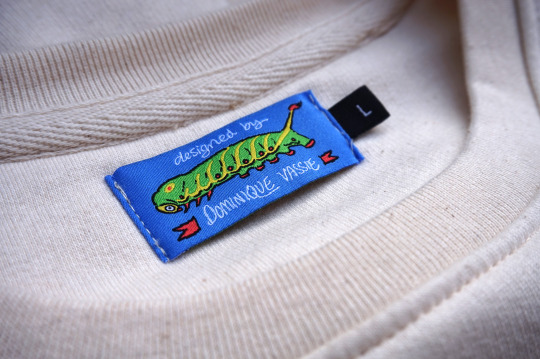
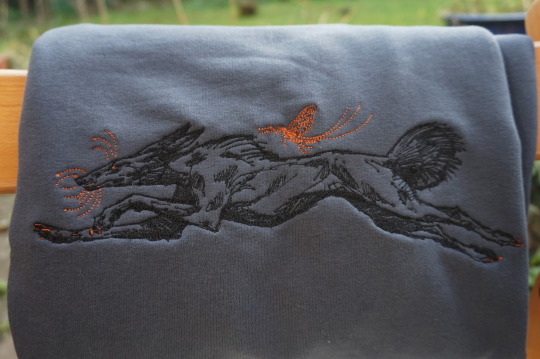

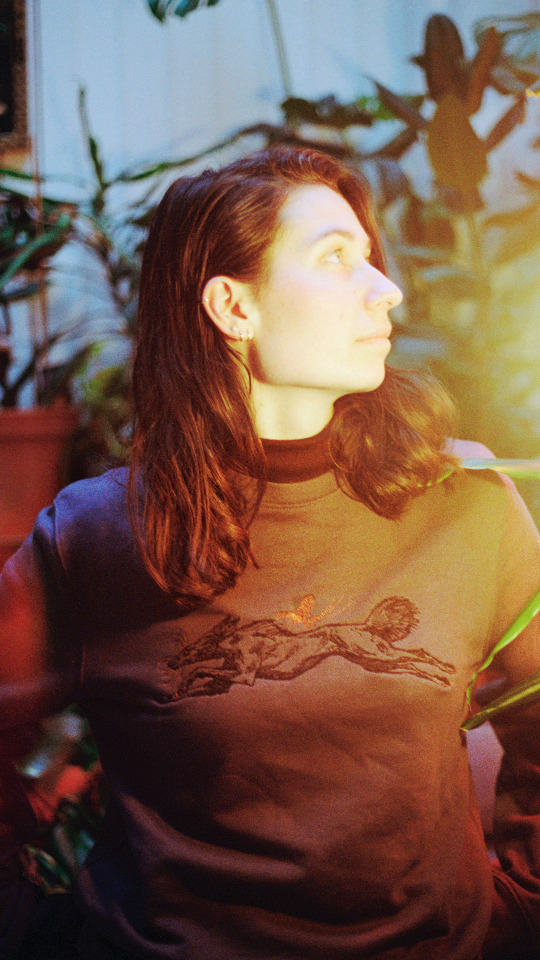
Something a bit different: finally launching my first embroidered design in collaboration with the wonderful 1831 Studio, London! Featuring a funky speedy creature and a mayfly. 𓃩𓆤
Preorders will close in 2 weeks at 5pm UK time on Thurs 4th April 🌸
------------------------------------------------------
1831 has done such a wonderful job in translating my sketchy lines into thread. These cosy sweatshirts are organic cotton and will be made to order to minimise clothing waste. There are two colourways: black and gold on off-white or the more subtle black and burnt orange on grey.
If you live in the UK, there is also an option to send in/drop off a piece of clothing you already own to have this design stitched onto it.
------------------------------------------------------
Please pre-order in my online shop! 🌱🌻🌸
------------------------------------------------------
These will be handled by 1831 Studio directly so any other items in the shop will be sent separately. Thank you for the lovely support as always! ❤️
Film photos by Ryan O'Reilly / @ardeavalley
#sweatshirt#embroidery#digital embroidery#jumper#sweater#clothing#apparel#creature#animal#mayfly#animal art#drawing#fashion#artists on tumblr
212 notes
·
View notes
Text
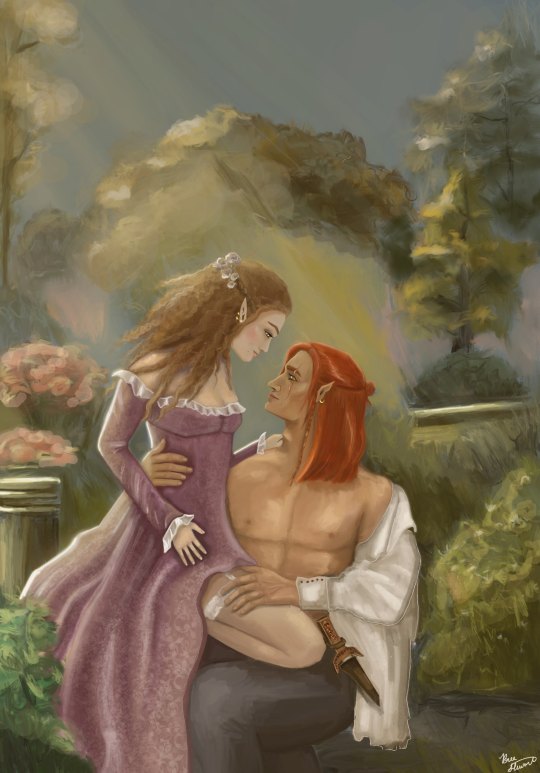
“He could not be mistaken. There were no other eyes like those in the world. There was only one creature in the world who could concentrate for him all the brightness and meaning of life. It was she.”
- Leo Tolstoy, Anna Karenina
In collaboration with @crazy-ache, we commissioned artist @dangerouslovesong to create this beautiful Elucien piece.
The vision: we have become a little obsessed with 1970-80s romance clinch covers. Not only are the poses romantic and sensual, but the artistry is exquisite. When @dangerouslovesong started her hand at Elucien fanart a few months back, she told me she was inspired by those covers and wanted to try tackling this challenging style. So, a few weeks ago, we all put our heads together to come up with a design and she executed this really magnificent piece!
She even did a worn book cover version!
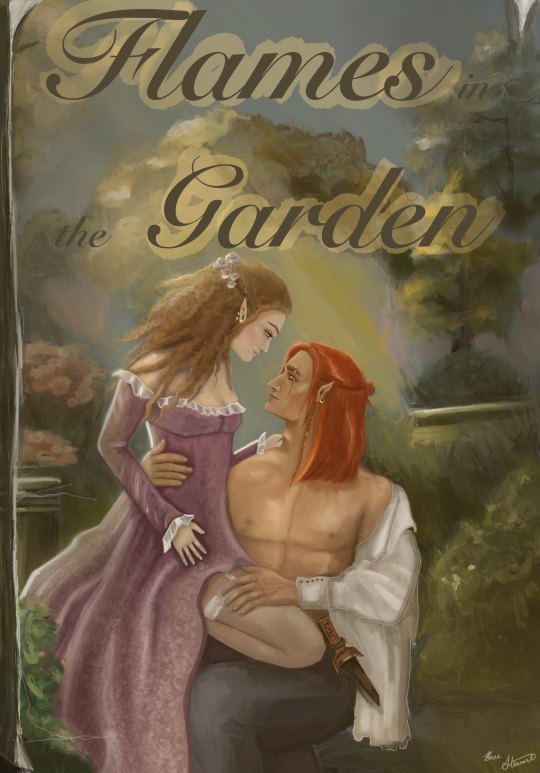
We thought what with the book announcement looming and fandom getting tense, having a little dreamy version of our own Elucien book would be fun. I personally think she captured the romanticism of the art style perfectly.


Some close ups for you all to appreciate some of the details.
#elucien#lucien vanserra#elain archeron#elain x lucien#pro elucien#elucien fanart#acotar#acotar fanart#elucien supremacy
182 notes
·
View notes
Text
11 more hot takes/unpopular opinions with DC and Marvel Comics

Originally this was 10, but I had one more to mention. And remember how my first post was Marvel-centric? This one is DC-centric.
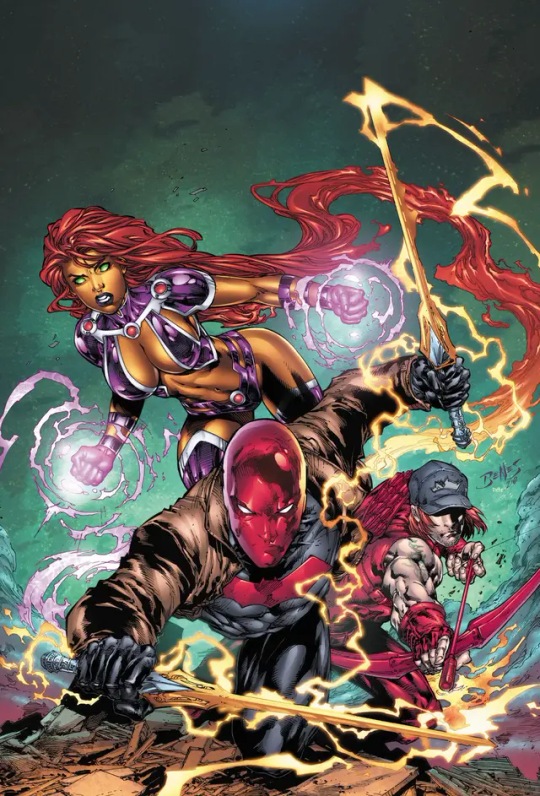
Starfire and Arsenal were better Outlaws than Bizarro and Artemis and deserve another shot--I know I phrased this like a fact, but all this is subjective. I find Arsenal and Starfire more interesting characters and enjoy their chemistry with Jason and their romance with each other. I just wasn't crazy about the art we got for their run, nor the blatant oversexualization of Starfire.
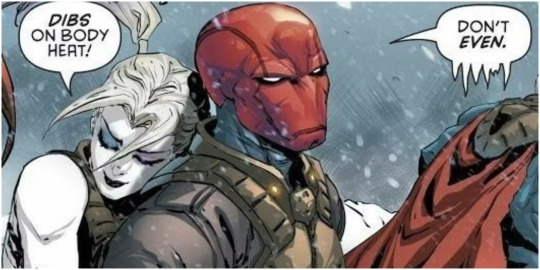
2. Harley Quinn and Red Hood are the next-gen Joker and Batman (and I ship it)--I've thought about this forever, but Jason's broody, solitary-except-when-he-needs-to-collaborate nature reminds me of how Batman is commonly depicted, though Jason is a more violent version. Harley, being a whimsical and goofy antihero, thus feels like the next-gen version of her ex (though I understand if you find Punchline or Joker's Daughter as more deserving of that). I'd also love her on an Outlaws team with Jason and Ghostmaker. I also always felt like they'd have better chemistry than the popular Nightwing/Harley ship (which I never really shipped, especially with how they've had Harley sexually harass him in the past). That said, this works best if Harley joined Joker post-Jason's torture.
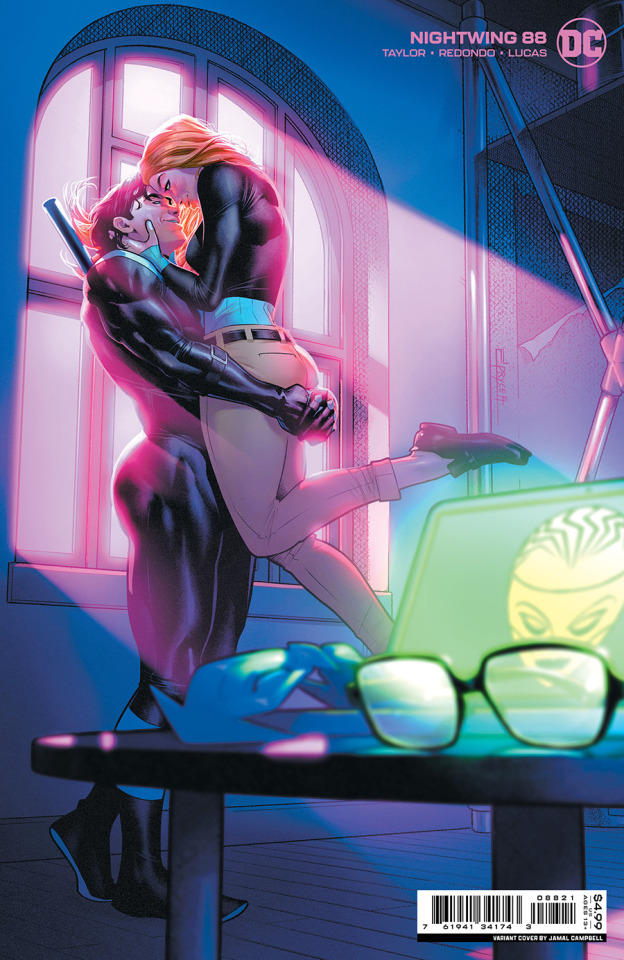
3. Jamal Campbell is the best cover artist for DC--His Nightwing art has me in a chokehold, and I love it! I also appreciate him making Nightwing curvy without it being from an ogling angle (see #5). That said, his actual work on Nightwing's issues isn't as good, but I think that's a time issue.

4. Travis Moore is the best issue artist for DC right now--I fell in love the moment I saw his work on "Wonder Woman." He's who I'd want as the artist for a "Red Hood and the Outlaws" series with Starfire and Arsenal. Really want him to do Nightwing, Titans, and a Tim Drake solo. Serg Acuna is a close second, but I'm not crazy about how he draws jawlines; they're more angular while I prefer them rounded.
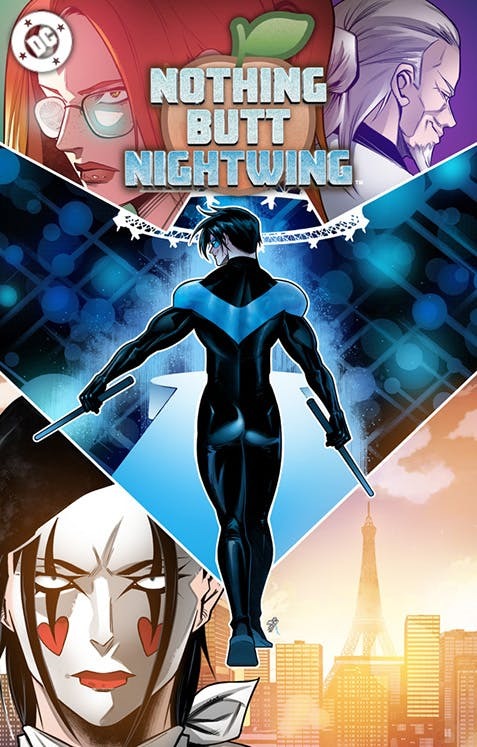
5. DC needs to stop objectifying Nightwing--It's one thing to be sexy; that's cool, and it's something that the subject can (kind of) control. But Dick is constantly objectified and harassed, as well as being the victim of sexual assault on more than one occasion. Personally, I headcanon him "being okay" with the harassment and objectification in-universe due to the trauma of being assaulted and not wanting to make the situation worse, but in any case, he should be a superhero first, sex object second. You can have him be attractive without predominantly being eye-candy; I hate how Harley Quinn's tv show, "Gotham Knights," and "Nothing Butt Nightwing" wanna not only bring attention to him solely for his curves, but make him vain about it just so no one can criticize the harassment.

6. Marvel needs to stop going the demon route with Nightcrawler (especially now)--Given Kurt's kindness and Catholic faith (that fluctuates based on the writer, I guess), his appearance as a blue creature with a tail is mainly for ironic purposes. I hate how every now and then, they like to lean into the demonic angle for him, since it undermines his character SO MUCH. Plus since his birth has been retconned (hopefully for the last time), it makes no sense to connect him with demons.
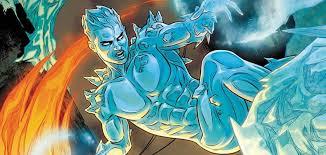
7. Iceman has fallen out of favor with me--I don't think his solos have been very interesting, and it feels like they've made his sexuality a personality trait. I'd prefer he just stays a team member on an X-team (and eventually date Somnus if Daken is still unavailable).

8. Major X needed a rehaul, but he had potential--I already did a post on this, but the gist is that he needed a new everything: different dad (because not everything has to circle back to the Summers-Grey clan), different powers (because OP telepaths are a dime-a-dozen), a more unique costume in design and color, having a different storyline than "I came to prevent a terrible future," and MAYBE make him from Earth-13729 because I like some of the characters. Basically just keep Storm as his mom, lol. And this isn't a must, but as an advocate for more original LGBT+ characters, making him part of the community would be neat in my book.

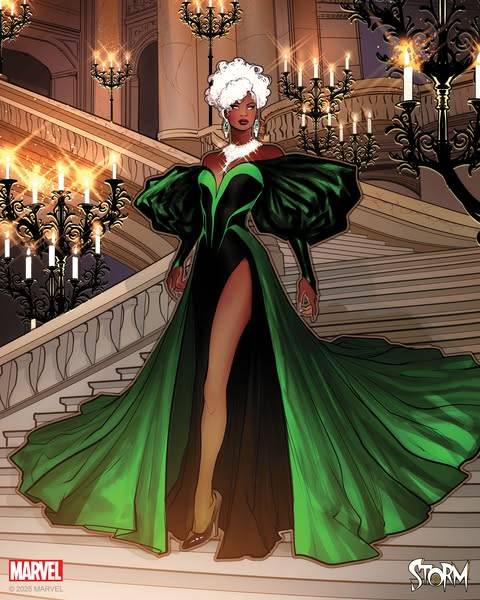
9. Russell Dauterman and Lucas Werneck are the best artists at Marvel right now--This is my "argue with the wall" opinion, lol. They've made amazing art, and I wish they'd do the art for every X-Men comic, imo.
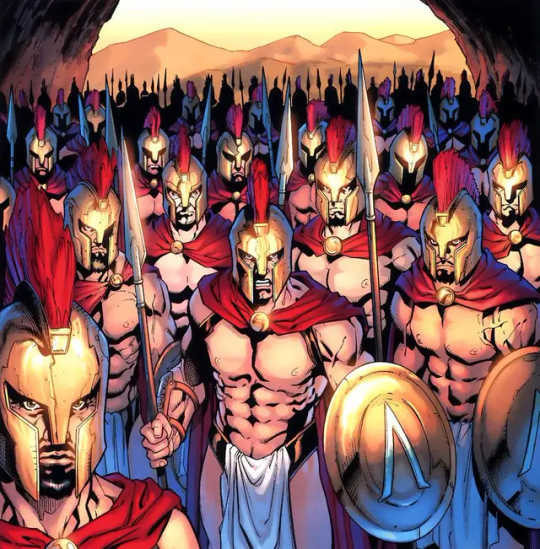
10. Where are the Gargareans?--It disturbs me that in the course of 15 months, DC had two storylines about a young man abandoned by his Amazonian mother and being (understandably) bitter about it when he finds out. Not to say everything would've been fixed, but aren't the Gargareans the male counterparts to the Amazons? The circumstance of sons of Amazons being abandoned by their mothers as per the rules of Paradise Island is never resolved despite the son's frustration and hostility. It's just like "oh yeah, that happened. Moving on!"
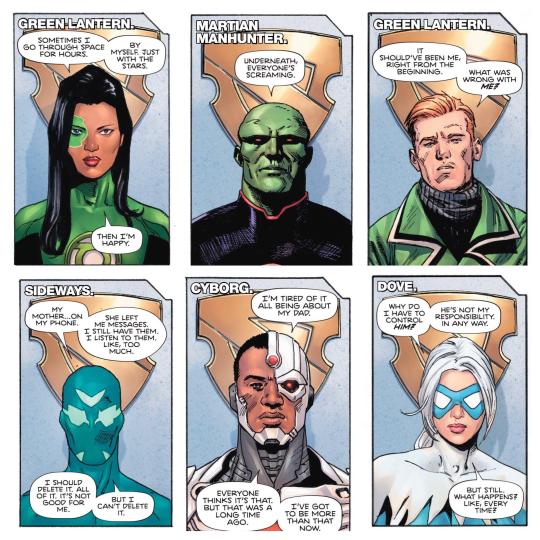
11. HiC was necessary (just not as it was)--We didn't need a murder plot for this to be good. Booster Gold and Harley Quinn being a duo with cute shenanigans around a serious premise was enough. Let these heroes get therapy once a year (or more; the issue itself could just be annual), and let us see these characters GROW, creating a stricter writing style for writing them rather than the flimsy style superheroes often face with different writers or when publishers go through a change in priority.
Hope you enjoyed this post! Any hot takes you agree with?
#dc comics#marvel#marvel comics#xmen#x men#nightcrawler#iceman#starfire#red hood#arsenal#red hood and the outlaws#ghostmaker#nightwing#dick grayson#titans#legion of x#major x#scarlet witch#storm#wonder woman#heroes in crisis
34 notes
·
View notes
Text
Much to people's fear, I played the notorious new kaneko's game



(dat shining carpet)
And surprisingly, It was alright. (Aside from the AIslop)
I can't read japanese, but the game was simplistic enough. Put a card on the slots to block damage, or attack the enemy. Every cards has their own attack+defend stats and unique effects and being a roguelike, you'll need to collect the right cards to defeat the bosses and ascend. It was surprisingly challenging


obviously, one element that held it back was the AI


Kaneko's work isn't that fully washed yet. While it's not of a high output compared to his glory days of maken X, persona 2, soul hackers, nocturne and whatsoever. Some demons like Aillen are nice.
The problem with the AI, ethics aside (tho they stated that they used kaneko's own works as the pool, no other copyrighted stuff), was art cohesion. And this is causing some inability to form attachment




In a monster collecting game (or anything that's focused on creatures ensemble instead of human cast), obviously they'll get more priority in term of character designs so you'll feel more attached to them. The focus on monsters are the reason why many monster hunter clones fails to take off (Maybe god eater is the exception)
It's coz they focus too much on multiplayer experience, but never lets you care about the monsters beyond "Beat this guy and get materials to craft a better gear to beat a more stronger guy, repeat ad infinitum"

The problem with the AI generated content in the game was, the designs are so unmemorable and lacked the "iconic" part.
And worse of all, since there's demon cards I liked to use because of its usefulness and personal strategy, they fall flat into unmemorable territory because of its uninspired "art style and design" (due to AI)
"why are demons A looked like this? Why does monster B looked like this?" In religion. Most Gods gets attributed to certain objects.
When you think of a blue throat guy with snakes on his body, matted hair and his iconic trishula, it's obviously Shiva. Persephone with pomegranates, Poseidon with his trident, etc. etc.
Character designs are like that, simply there's an icon/fashion/attributes to represent their personality and role.
But AI are sadly biased to surface levels interpretation, which makes an uninspired forgettable depiction. (Usually they'll be remembered more for its coombait/COOL shock factor but that's another story)


it also looked out of place compared to kaneko's actual design, and hilariously enough, kaneko seemed to be more honest that these AIs are fake(?) but sadly inevitable.




Most (AA+) game studios these days probably secretly used AI in their backrooms. Once a staff who worked at southeast asian branch of bamco told me on how AI is rather widespread in bigger industries and human artists are only there to clean the AI's mess to hide its involvement
With art style being pigeonholed to hyperreal super detailed or flat anime with softer details (compared to 90s with stylized anatomy and stronger shading), it seems to be more easier for AI to seep through the cracks
---
Had this game ditch the AI and opt for collaboration, maybe it'll be more memorable compared to just utilizing AIslop, but that means colopl needs to pay more freelancers, and for obvious fucking reasons, studios really hates paying their artists.
Mobage/Gachas are known to have large roster of character designer anyways. Even niche ones like housamo/GYEE could still get one, why not Tsukuyomi?
I know there's still art direction problem, but humans are more easy to keep track of compared to AI's randomness (and limited pool since they didn't use copyrighted materials)
Plus a collab would've be cool. Imagine a return of Araki ft. Kaneko again
...Problem is, we know there's a community of artist to select for said collab. FGO/XC2 usually employs popular big name game artists (sometimes hentie ones), housamo/GYEE obviously selects from gay (men) media pool. But is there a community of people who loves folklore/myth/monster design...?
---
Another lost chance is to implement tarot card / card rider imagery to a game where cards are the main gimmick

I know personastans are gonna seethe at the game "IT'S PLAGIARISM!111" (wouldn't that make it self plagiarism?) since they thought persona 5 invented jazz and japan before izanami and izanagi went down to earth.
Card rider imagery would rather be funny since Tsukuyomi's bent towards tokusatsu aesthetic. (A big irony when you think how even more tokusatsu'd SMT was post IV with its super sentai odin and fang joker zeus) , but it'll be more fitting
There's so much missed opportunity to implement these aesthetic, which sucks since the game is rather well made (aside from the AI, which from my point of view. Feels more of a gimmick)
I know they inserted AI because it fits the random nature of roguelike, but I wish there's more better option than using AI to generate unmemorable slop
Well, at least Kaneko was more aware. This is a contrast to bunch of normie non artist bigwigs that worships AI like it's godjesus creator of mankind.
Sadly, this game feels more like a "Featuring Kaneko from the SMT series!" compared to a full fledged "Kaneko's game" like his past works
I'd say it's more of the industry problem opposed to Kaneko's problem. If you designed 600+ demons and humans, defined the image of a small company, and even made jack frost, but got no royalty from it. Wouldn't you be just pissed?
Maybe we're just too harsh on artists, man. Blame the higher ups for stirring horizontal conflict because no matter how much talent an artist have in their field, it's ALWAYS those higher up with privilege, money and higher position on their nameplates that always get the final say over everything, regardless if it's good or slop
It does make me wonder how Kaneko would be if he's faring better at freelance, at least Yoshitaka Amano returns to draw arts for new final fantasy games and still exhibits his works or freelancing
but KNK? zamn :(
--
Sauce :
Interview 1
Interview 2
27 notes
·
View notes
Text
Technoverse - A guide for interaction roleplay and insert wise.
This was EXTREMELY requested
This blog exceeds to help newcomers to my AU environment. This blog will be updated over time if I see fit to change how this works interacts with itself. This blogs images will be updated over time if I find more suitable matches.
Photos have been found through Pinterest and art station. I will try and credit the source if I can.
This is an AU inspired by Rise of the Teenage Mutant Ninja Turtles. This is a free to join au. Major canon characters are prohibited from being claimed. Villains are up to discussion.
This is a isn't the backstory post of the turtles but the world they live in.
THIS AU CONTAINS TOPICS OF RACISM, ILLEGAL SUBSTANCES AND ACTIONS, AND VIOLENCE. Though I've done my best to try and make it as friendly as possible. This AU is a 16+ story due to these warnings.
Current AU time
25 years after the ROTTMNT movie.
AU Theme
Cyberpunk dystopia
Fantasy
Dark fantasy
Major city settings within AU
New York, Hong Kong, Tokyo, Seoul, London
City Summary
After the integration of Yokai as independent civilians and free citizens world wide, and with the collaboration of their technology as well as krang salvage, a new system of buildings and interlinks have been created to accommodate citizens. Buildings stacked overhead that pierce the clouds, the old world was left to turn into slums and poor living areas on ground zero. Due to permanent clouds caused by pollution and overhead cities, these major empires are in a permanent state of darkness. Neon signs often light these cities to create a spectacular aroura of lights and designs. Though with a permanent overcast comes with a cost, as rain clouds mix with polluted smog to create a toxic like rain that causes many illnesses. It's common among every citizen to keep an oxygen mask at all times in case of rain.
City main inspiration and reference: Altered Carbon





Major cities as listed above are unique as floating SSC (Solar System Cosmopolis) Cities cover most of the dense populated area. These floating cities serve as purpose as secured homing for politicians, celebrities, and mostly the rich. Though they are also engineered mega labs founded by Barron Draxum and Donatello Hamato. They serve to bring back and study extinct species, cultivate cures for major diseases, and help improve on already futuristic technology. They spin very slowly and resemble that of a solar system. Hense the nickname.
These cities are held afloat by a self sustainable gravity generator that uses the gravity of a man made miniature star; created by Donatello Hamato (age 20).
Main inspiration from CMD Studios recent project!!!

Hidden cities
These main cities are focused world points for another reason. They rest above other hidden cities in which they have their own theme and setting.
New Yorks hidden city belongs to Big Mama, a spider Yokai who deals in illegal gambling and the distribution of illegal mystic items. NY Hidden city remains as a hub for traveling species of Yokai from all around the world.
Hong Kongs hidden city belongs to [REDACTED TBA]- A Dragon Yokai who deals in illegal sales of mystic items and krang salvage from the old battle.
This hidden city is less developed than the others, as most accomodation plans have been denied to preserve its pristine buildings and history. This hidden city resembles deep mountain caverns with buildings built into the sides. Common mystical creatures from Chinese mythology live within this city and rarely travel. Humans are not allowed.
Main inspiration by David Noren!
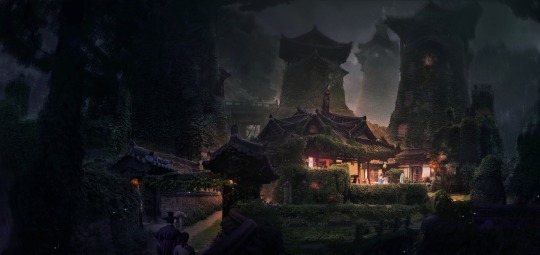
London's hidden city belongs to [REDACTED TBA] A plant like fairy Yokai who often helps with creating forged ID's to help Yokai find a better place to live. She also is known to sell potions that aren't approved by the hidden cities overlords and FDA.
This hidden city has developed slowly over time, but due to quick overgrowth of plants and trees. Most buildings have been built into large glowing trees that hang over the city in beautiful rainbow colors. The ground is a great hub for growing fruits and herbs for medicines. The Yokai in this hidden city are spirits from English folklore. They have spread over different cities over time.
Main inspiration found on Thin blue line on Pinterest!
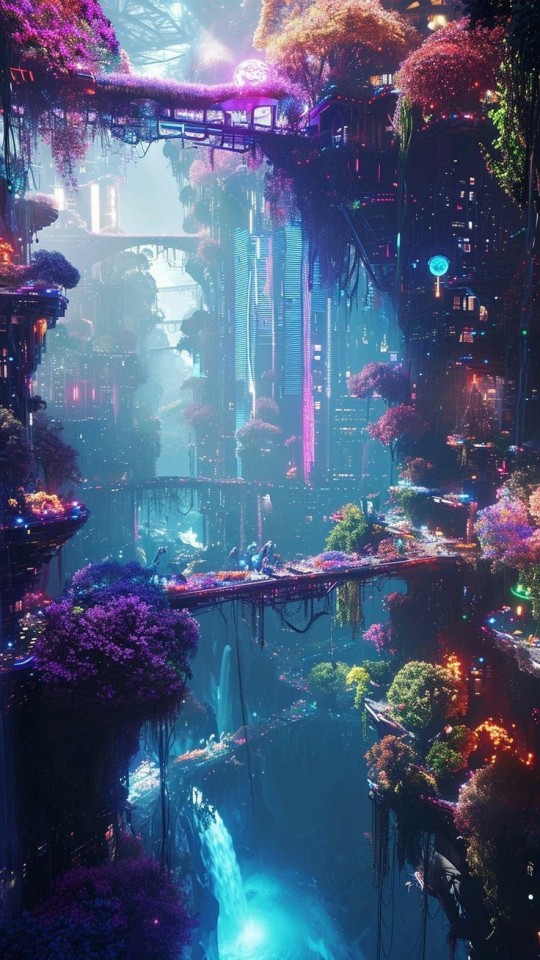
Seouls hidden city belongs to [REDACTED] a Polar Bear Yokai who deals in illegal weapon distribution and species trafficking.
This hidden city is up to date and mostly in an indoor environment due to this hidden city being within a freezing temperature climate. More artic themed Yokai live within, but this hidden city is popular as a summar retreat by humans and other Yokai looking to stay cool for the summer. But this hidden city isn't as welcoming to humans as the others.
Main inspiration by Annabale Siconolfi!

Tokyos hidden city belongs to Yeosobai. A jellyfish Yokai who deals with handles most black markets and distribution of illegal substances.
This hidden city is completely underwater. Surrounded on a deep voided ocean under Japan, pod cities have been added to accommodate air breathing citizens, though most buildings were air tight even before. This hidden city is also a large hub for tourists due to its underwater appeal. This city distributes most seafood around the county. Known for its large amount of attractions and adult clubs, it's also a very crime ridden city.
This is also where Current Donatello resides.
Main inspiration creator unknown

Human and Yokai stances
With the sudden booming population of mutants and Yokai integrating into human society, of course tensions and protests by humans were bound to happen. A world they were so used to was building into something unknown before their very eyes after all. And so, tensions between species rose.
Humans with a deep dislike towards other species either hide their hate, or become extremists. Often getting tag as cultists as over years hate crimes toward Yokai and mutants became a world wide situation. Yokai were often kidnapped from their homes to be found barley recognizable by their attackers. Yokai would retaliate, and after much tension, civil wars broke out. Protests for safer living for both species were in demand, and so most governments integrated an artificial intelligence police force that contained mostly droids to prevent race picking. Most countries have adapted this form of law enforcement.
Cultists are still a major problem though their numbers have thinned.
The term Mutant has become a word to target Yokai and mutants in a hateful way, and this word soon became outdated. All non humans are now under the identification of Yokai. This includes mixed races between the two.
It's common for Yokai and humans relationships! Often by now the first generations of Yokai and humans hybrid children are born!
There are even schools for these rare breeds as they are still being studied as a new species.
It is illegal for most countries to have discrimination between species. No Yokai only or human only living spaces, restaurants, or shops.
Though within most slums there is a secret rule to separate the species as mostly disgrunted humans and Yokai live here.
And now we're here!
I want my character to join the au, but I don't know what's allowed!
This part of the blog aims to help you adapt your character into this new universe.
What should my character wear?!
It's really up to you! Most humans and Yokai wear mostly cyberpunk themed clothing! Often I find Pinterest as a source of inspiration. I think your character would fit better if it comes from a certain part of the world. Armor and glowing clothes are welcome and encouraged! Get creative!
I want my character to have cool robotic limbs and mods in their body! Is this allowed?
Yep! And encouraged! This is a futuristic setting! So modifications to the body aren't uncommon!
Can my characters have cool unique weapons?
Of course! And I'd love to see them!! 🔥🔥🔥
Do I have to ask before joining this AU?
Nope! But I'd love to see/read your creation! Or see that you're inspired to join!
Does my character have to be human?
Nope! Any species welcome!
Can my character already know personally main characters?
That's up for discussion. Current time Donatello isn't open to being known nor talkative to strangers. I'd like it if you didnt. He's playing dead unlike the rest of his brothers. Leo's up for discussion but with Mikey and Raph, they are more social and I can see them having multiple friends. Leo's treated more as a police officer and doesn't have a lot of friends due to his work.
Can my character work for the main boss Yokai of the hidden city.
Yes! I'd like you to stay close to what they do in terms of how they run things!
Can I claim ships with these characters?
NO.
Claiming ships with only your characters and main cast is prohibited. That's why Y/N is created as a medium for all 18+ participants that want to ship their characters with main cast. Ships are fun and welcome! But you cannot claim it as a you only ship.
Thank you for reading what I have for now! More to be added!
71 notes
·
View notes